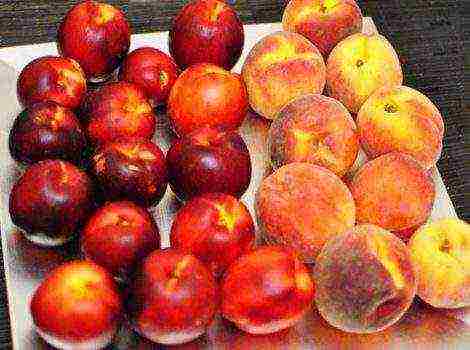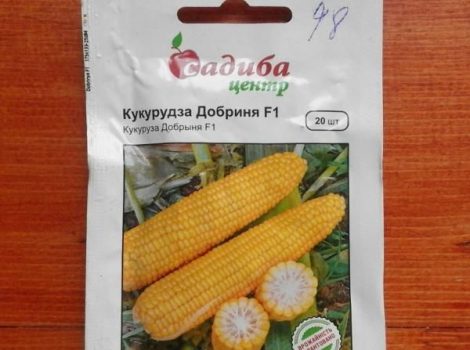Content [show]
Every gardener dreams of growing an apricot tree. The fruit of this plant is of undoubted benefit. It is delicious and aromatic. It is usually eaten fresh. But it is also ideal for making preserves, compotes, jams. Having planted just a couple of apricot varieties, the summer resident will receive a rich harvest of ripe fruits. True, it is not so easy to decide on a specific variety of this fruit tree. After all, the assortment is striking in its variety. This article will describe the best varieties of apricots, which are characterized by resistance to ailments and cold.
Which winter-hardy variety of apricots should you choose?
Apricot trees grow on almost every summer cottage. The plant is very thermophilic, but today, thanks to the work of breeders, a lot of cold-resistant species have appeared. 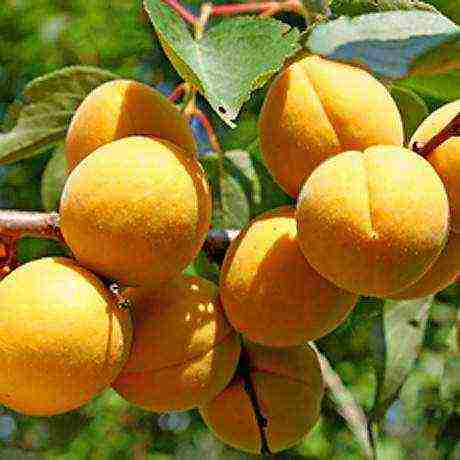 And if earlier this fruit crop was grown mainly in the southern regions, it became possible to plant apricots in areas that have a colder microclimate. Perhaps an interesting article will be about domestic and foreign early varieties of raspberries.
And if earlier this fruit crop was grown mainly in the southern regions, it became possible to plant apricots in areas that have a colder microclimate. Perhaps an interesting article will be about domestic and foreign early varieties of raspberries.
Below are the best varieties of apricot, which are characterized by increased winter hardiness:
- Hardy.
- Best Michurinsky.
- Red-cheeked.
Apricot Hardy
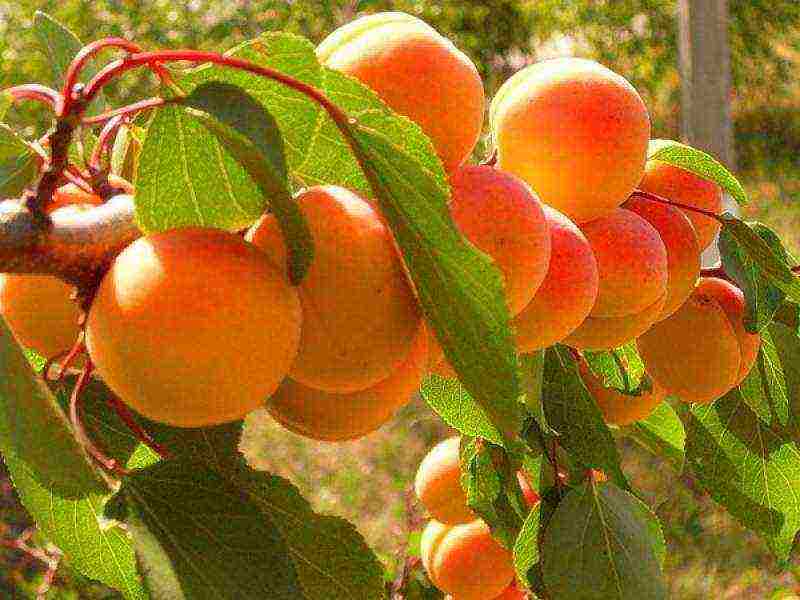 This variety is recognized as the most hardy in terms of withstanding low temperature indicators. Therefore, summer residents of the Moscow region often choose this variety. It should be noted that winter-hardy properties extend not only to the tree itself, but also to flower buds.
This variety is recognized as the most hardy in terms of withstanding low temperature indicators. Therefore, summer residents of the Moscow region often choose this variety. It should be noted that winter-hardy properties extend not only to the tree itself, but also to flower buds.
The plant is vigorous. The crown is large, rounded, medium thickened. Hardy enters fruiting 5 years after planting. The yield is high and stable. At least 70 kilograms of fruit are usually harvested from one tree. Each fruit weighs between 30 and 45 grams. The skin color is golden orange. There is a carmine blush. The pubescence of the surface is minimal. The pulp is orange. The taste is pleasant sweet. The advantages of the variety include the presence of good immunity to most ailments and the self-fertility of the plant.
Apricot Best Michurinsky
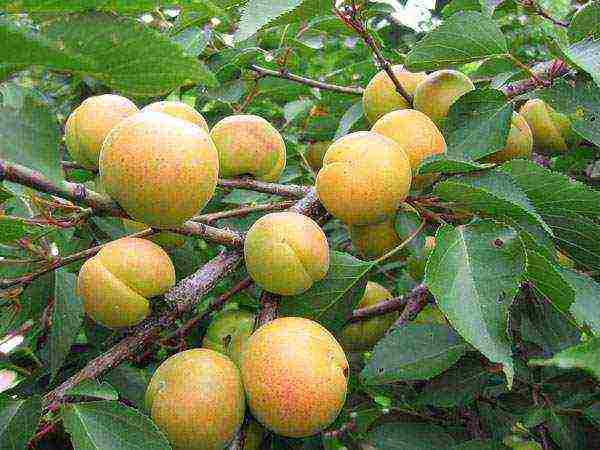 It is worth considering the description of the Apricot variety Best Michurinsky as one of the most popular at the moment. The variety is medium late. It is characterized by good yield and high winter hardiness. The best pollinator for Michurinsky is the Tovarish variety. The tree begins to bear fruit after 5 years from the moment of planting. Fruits ripen in the first decade of August. Apricots are small in size. Their weight does not exceed 15 grams. The shape is flattened-rounded. Yellow color. There is a slight blush. The pulp is dense, yellow, has a sweet and sour taste.
It is worth considering the description of the Apricot variety Best Michurinsky as one of the most popular at the moment. The variety is medium late. It is characterized by good yield and high winter hardiness. The best pollinator for Michurinsky is the Tovarish variety. The tree begins to bear fruit after 5 years from the moment of planting. Fruits ripen in the first decade of August. Apricots are small in size. Their weight does not exceed 15 grams. The shape is flattened-rounded. Yellow color. There is a slight blush. The pulp is dense, yellow, has a sweet and sour taste.
Apricot Red Cheeked
It is an inexpensive, popular apricot.It is highly appreciated by domestic summer residents for its frost resistance and unpretentiousness. The seedling takes root not only in the northern, but also in the southern climate. The tree produces large, rounded fruits. The harvest ripens in the month of July. The pulp is sweet-sour taste, pronounced aroma.
Which self-fertile apricot variety should you choose?
Self-fertility is a useful property of the apricot tree; under it, the plant's ability to self-pollinate is increased.
Due to this, the summer resident is guaranteed to receive a rich harvest, regardless of whether another fruit tree grows nearby or not. Therefore, many farmers tend to plant self-fertile apricot varieties on their personal plot.
Below are the best self-fertile apricot varieties that are enjoying good popularity:
- Dessert.
- Sardonyx.
- Northern Triumph.
Apricot Dessert
 Many beginners and already experienced summer residents choose this variety. Therefore, it makes sense to consider the description of the Dessert apricot variety in more detail. A tree of medium height grows. The crown is round and rather sparse. Annual shoots are thick. In the middle lane, there is a good winter hardiness of the plant and flower buds.
Many beginners and already experienced summer residents choose this variety. Therefore, it makes sense to consider the description of the Dessert apricot variety in more detail. A tree of medium height grows. The crown is round and rather sparse. Annual shoots are thick. In the middle lane, there is a good winter hardiness of the plant and flower buds.
The fruits are medium in size. Their mass reaches 35-40 grams. The shape is rounded, strongly flattened from the sides. The surface is painted yellow. Pubescence is strong. The pulp is light orange, crispy, medium in density. The taste is pleasant, sweet. There is a hint of sourness. The aroma is pronounced. Fruits ripen in mid-July.
Apricot Triumph north
 The plant is vigorous. Usually reaches 4 meters in height. The crown is wide, medium branching. The fruits are medium in size. Their weight is about 60 grams. The shape of the apricot is oval, asymmetric. Ripe fruits are colored yellow-pink. The pubescence of the skin is not strong. The pulp is juicy, sweet and sour. Triumph begins to bear fruit at the 5th year of life. From the age of 10, more than 50 kilograms of the crop are harvested from one plant.
The plant is vigorous. Usually reaches 4 meters in height. The crown is wide, medium branching. The fruits are medium in size. Their weight is about 60 grams. The shape of the apricot is oval, asymmetric. Ripe fruits are colored yellow-pink. The pubescence of the skin is not strong. The pulp is juicy, sweet and sour. Triumph begins to bear fruit at the 5th year of life. From the age of 10, more than 50 kilograms of the crop are harvested from one plant.
Numerous reviews of the Northern Triumph apricot indicate that the variety is the best for growing in Siberia. Among the advantages summer residents note self-pollination, early maturity, high productivity. However, it must be borne in mind that fruiting is very unstable.
Apricot Sardonyx
This is a medium late variety. The apricot Sardonyx ripens in early August. The tree is winter-hardy, medium-sized, fast-growing and fruitful enough. The fruits are large. They are ovoid. The average weight is 50 grams. The plant enters fruiting at the 4th year of life.
What varieties of apricots are resistant to moniliosis?
Often, apricot infects moniliosis, fungicides are used to combat this disease, however, chemical treatment of wood is not always safe.
In addition, the process becomes more difficult in rainy weather. 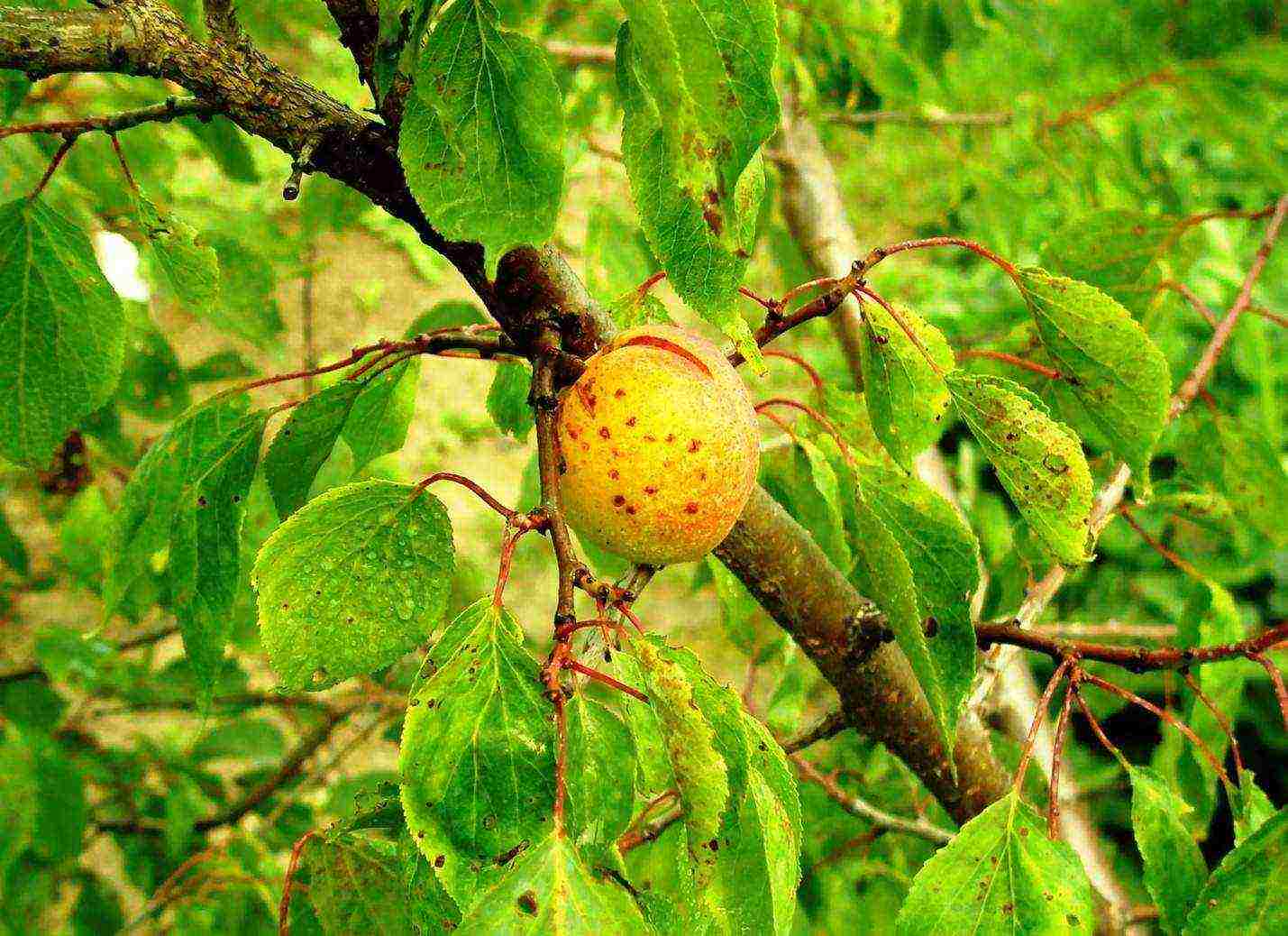 Therefore, gardeners often plant apricot varieties resistant to moniliosis in their area.
Therefore, gardeners often plant apricot varieties resistant to moniliosis in their area.
These varieties include:
- Special Denisyuk.
- Monastyrsky.
- Goldrich.
Apricot Special Denisyuk
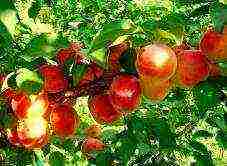 Today, many varieties are known that are immune to moniliosis. The most demanded is the Special Denisyuk. Late ripening variety. The tree is medium-sized. The crown is not particularly thickened. Productivity and winter hardiness are high. The fruits are characterized by an unusual carmine color. Largest in size. Good-tasting pulp, juicy. Ripe fruits are capable of not falling off the branches for a long period.
Today, many varieties are known that are immune to moniliosis. The most demanded is the Special Denisyuk. Late ripening variety. The tree is medium-sized. The crown is not particularly thickened. Productivity and winter hardiness are high. The fruits are characterized by an unusual carmine color. Largest in size. Good-tasting pulp, juicy. Ripe fruits are capable of not falling off the branches for a long period.
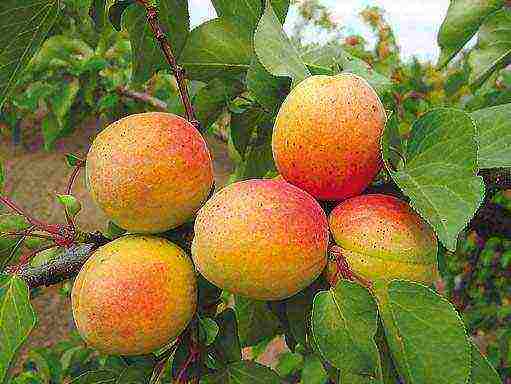 Monastic apricot
Monastic apricot
A variation of the average ripening period. The plant is short. The crown is round. Winter hardiness and productivity are good. The fruit is quite large. They are yellow-orange in color. There is no blush. Monastyrsky is distinguished by its unsurpassed aroma and excellent taste. For which he was very fond of domestic gardeners.
Apricot Goldrich
The plant is medium-sized. The crown is spreading, wide. Goldrich is characterized by productivity, winter hardiness, immunity to moniliosis and shark.At the moment, this is the largest-fruited variety. The apricot mass reaches 90 grams. There are specimens weighing more than 100 grams. The shape of the fruit is oval, slightly flattened on the sides. The skin is orange with a slight red blush. The pulp is firm, dark orange. The aroma is light, pleasant.
Which columnar apricot variety should you choose?
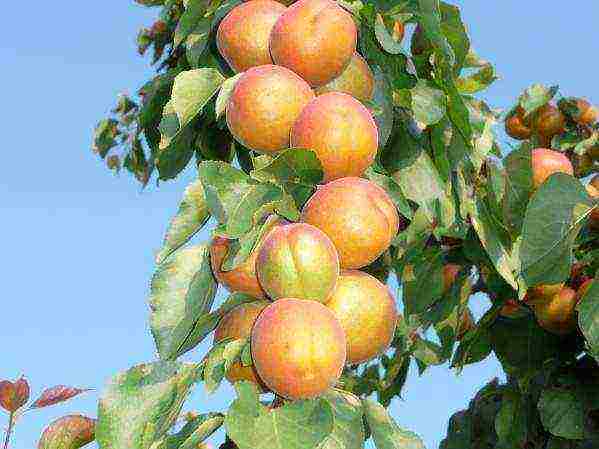 Not every summer resident can boast of a large personal plot. And everyone wants to create a garden. In the case of a limited area, it makes sense to pay attention to the columnar varieties of fruit trees. They take up little space, grow in the form of a column, from which small branches extend. Having planted the best varieties of columnar plums and apricots, the garden will look neat and beautiful.
Not every summer resident can boast of a large personal plot. And everyone wants to create a garden. In the case of a limited area, it makes sense to pay attention to the columnar varieties of fruit trees. They take up little space, grow in the form of a column, from which small branches extend. Having planted the best varieties of columnar plums and apricots, the garden will look neat and beautiful.
There are many varieties of columnar apricots. But the Prince variety is especially popular today. This is the most productive tree. The plant is early maturing, does not need a pollinator, and has excellent resistance to low temperatures and diseases. The reviews are mostly positive.
What varieties are there by ripening time?
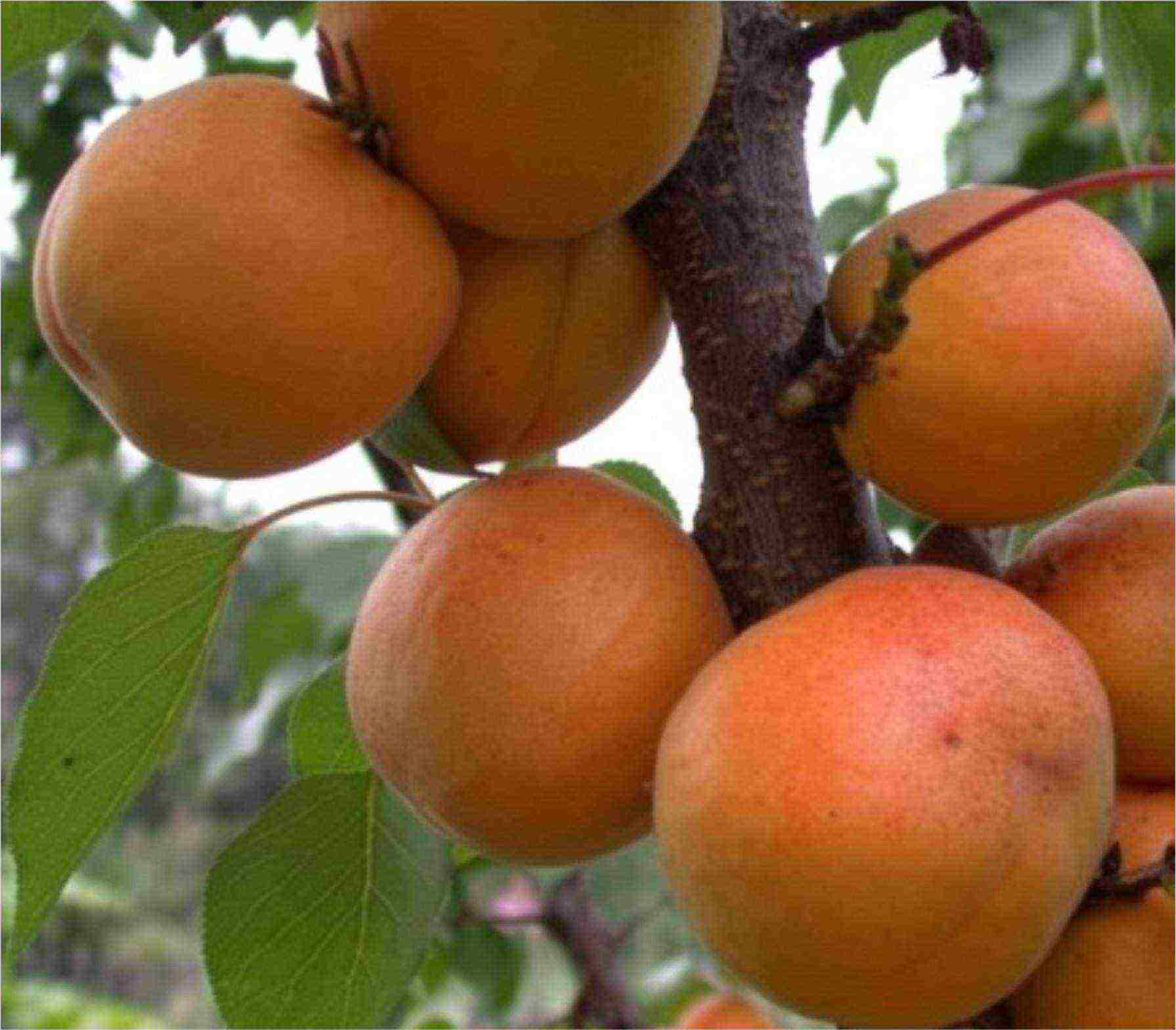 Depending on the period of fruit ripening, all apricots are divided into early ripening, mid-ripening and late-ripening. The first is the Alyosha variety. Also good reviews about apricot Zhigulevsky souvenir, June. Among mid-season varieties, Altair, Olympus, Aviator, Amur, Phelps, Aquarius are most often chosen. Having decided to plant a late variety of apricot, it makes sense to pay attention to the apricot Hargrand, Sirena, Kostyuzhensky, Iskra. It is advisable to plant several types of fruit trees with different ripening periods. Then the summer resident will enjoy fresh fragrant fruits for much longer.
Depending on the period of fruit ripening, all apricots are divided into early ripening, mid-ripening and late-ripening. The first is the Alyosha variety. Also good reviews about apricot Zhigulevsky souvenir, June. Among mid-season varieties, Altair, Olympus, Aviator, Amur, Phelps, Aquarius are most often chosen. Having decided to plant a late variety of apricot, it makes sense to pay attention to the apricot Hargrand, Sirena, Kostyuzhensky, Iskra. It is advisable to plant several types of fruit trees with different ripening periods. Then the summer resident will enjoy fresh fragrant fruits for much longer.
Conclusions about the best varieties of apricot
Thus, there are many varieties of apricot today. Despite the fact that this fruit is thermophilic, it can be easily grown even in the northern region. The main thing is to get a winter-hardy seedling. To choose the best variety, you need to understand the classification of fruit trees, the characteristics of each variety. Having decided on a specific species, you should study the features of planting and growing this crop. Usually, apricot is grafted onto plums, peaches or cherries. Look at the article: How and in what ways is a watermelon grafted on a pumpkin?
.
Apricot varieties for the Moscow region must have such qualities as frost resistance and resistance to fungal diseases. Winters in the region are very cold, autumn is frosty, and summers are often rainy, which is not suitable for all varieties of apricot.
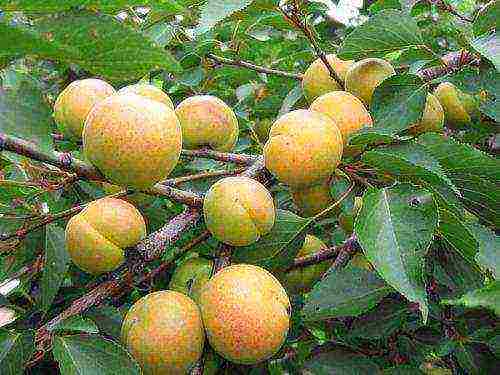
Apricot Michurinsky is suitable for growing in cool climates
Not all popular varieties are suitable for growing in the middle lane. Apricot is a thermophilic and photophilous plant, does not tolerate drafts, stagnant moisture.
Growing recommendations
Apricot trees are not planted from seeds in the Moscow region. Better to grow quality annual apricot seedlings. You can choose which variety to plant after studying their characteristics.
An illuminated place is selected on the site. The groundwater level should lie at a depth of at least 2 m. The soil should be neutral, if it is acidic, it should be treated with lime. Ideal soil composition: sod land, fertile garden soil, manure, sand. The bottom of the pit is lined with drainage, broken brick and sand.
If the plant is not self-fertile, you need to plant a pollinator next to it at a distance of about 5 m.
In dry summers, watering should be abundant (5 buckets per tree). In rainy times, the intensity of irrigation is reduced. Apricots need to be fed regularly: rotted manure, saltpeter, superphosphate and potassium salts are added.

Saltpeter should be regularly applied under the apricot tree
Main varieties
There are many varieties of apricot that are suitable for the climate of the Moscow region. The work of breeders has presented gardeners with plants that can withstand low temperatures, are unpretentious to the quality of the soil and give rich yields.The best varieties of apricot for the Moscow region:
- Alyosha;
- Aquarius;
- Varangian;
- Snegirek;
- Zeus;
- Michurinsky;
- Iceberg.
Breeding novelties are gaining popularity among gardeners of the Moscow region - the varieties Edelweiss, Iinohodets, Gviani. They are not inferior to the popular varieties Alyosha and Varyag in terms of frost resistance and taste of fruits. Even a decorative columnar apricot can be grown in the middle lane. The black-fruited apricot Black Velvet has a high frost resistance, but experienced gardeners do not recommend planting a plant in the Moscow region, since it will not bear fruit abundantly.
Michurinsky
The Michurinsky variety has high indicators of frost resistance and disease resistance. The plant is most commonly used as a rootstock for less resistant varieties.
Michurinsky bears small, tasteless fruits. The disadvantage of the Michurinsky variety is its susceptibility to moniliosis.
Alyosha
Apricot Alyosha is well suited for the middle strip. This is the most popular variety among gardeners in the Moscow region. Variety characteristics:
- The average height of the tree is 3 m.
- The crown is spreading, rounded.
- The flowers are large, white with pink veins.
- Fruits are medium, round, flattened on the sides.
- The pulp of the fruit is medium juicy, sweet and sour.
Apricot fruits ripen at the end of July. The large bone is easily separated from the pulp. The fruits can be stored for a long time, retaining their appearance and taste. Gardeners note the high frost resistance of the variety.

Apricot Alyosha - frost-resistant variety
Aquarius
The Aquarius apricot tree is very tall and powerful. Saplings take root well in the Moscow region and begin to bear fruit as early as 3 years of age. Description of the variety:
- Flowers are small, bloom in mid-March.
- The fruits ripen in mid-August.
- Fruits are large in size with a visible seam in the middle. The skin is yellow without blush.
In terms of taste, Aquarius is not inferior to others. Apricots are sweet with a slight sourness.
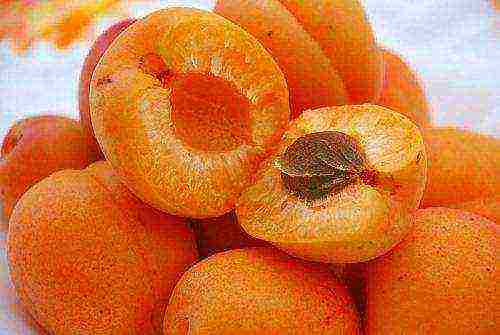
Apricot Aquarius produces large and sweet fruits
Zeus
Apricot Zeus is perfect for the climate near Moscow. Due to its high winter hardiness, it is also grown in the northern regions. Main characteristics:
- Average vigor. Maximum height 3 m.
- High frost resistance.
- Average resistance to moniliosis and other diseases.
- High yield: One tree produces an average of 20-30 kg of fruit.
- Fruits weighing 20 g, dense, light orange in color.
It gives the first fruits for 3 years of life. Flowers bloom in mid-March and can be harvested in mid-August.
To plant a tree, you need to choose the most illuminated area, do not forget to water (3-5 buckets of water per tree, depending on weather conditions).
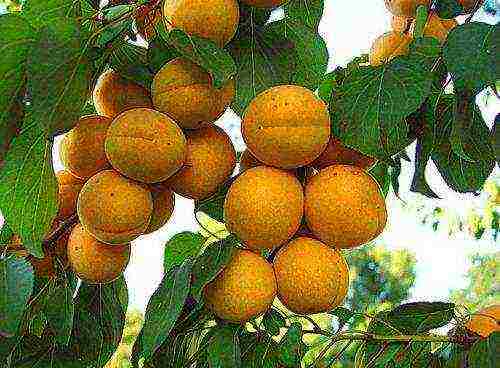
Apricot Zeus is a high-yielding variety
Snegirek
Apricot Snegirek has a record frost resistance. Trees are unpretentious to external conditions, soil composition. Apricots of this variety can be found in the gardens of the Urals, Eastern Siberia. They are ideal for the Moscow region. Differences:
- Short stature. The tree reaches a height of 1.5 m.
- High productivity. One tree produces 10 kg of fruit.
- Low resistance to disease. Most often trees are affected by moniliosis.
- Self-fertility. The flowers are pollinated among themselves or by neighboring trees of the same variety. This quality is very important for the climate of the Moscow region.
The fruits are very beautiful, have a bright orange color, elastic. High elasticity ensures good transportability. Fruits can be stored for a long time, keeping their presentation.
Snegirek is not resistant to fungal and bacterial infections, the action of parasites. This deficiency will help to eliminate regular preventive treatment with special drugs.

Apricot Snegirek is very frost resistant
Minusinsk Amber
Apricot Minusinsky Amber adapts well to the conditions of the Moscow region. It is a relatively hardy variety. The main advantage of the plant is its good regenerative ability.The tree is very beautiful, with a pyramidal crown. Its fruit is oval, yellow in color and has an orange barrel. Sweet apricots with a slight sour taste are highly valued by gourmets.
Amber gives average yields, 8 kg of fruit can be harvested from one tree. Apricots tolerate transportation well.

Apricot Minusinsky Amber is a great option for the Moscow region
Iceberg
Hybrid apricot Iceberg was bred by Russian breeders. This is one of the most unpretentious early varieties. The advantages of this variety:
- The trees are of medium height.
- Large fruits with excellent taste.
- High productivity.
- Ripening period - mid or late July.
- High resistance to the action of fungi, bacteria and insects.
- Average winter hardiness.
Planting "Iceberg" apricots in the Moscow region is recommended in the spring. The optimal time is the beginning of April, when stable heat is established and the snow melts. The Iceberg variety requires protection from the through wind. It is best to plant the tree next to a hedge or fence.
Pollinators "Iceberg" are varieties Alyosha, Lel, Tsarsky. They also adapt well to the climate conditions of the Moscow region.
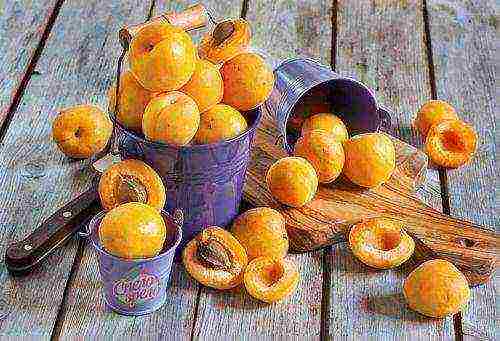
Apricot Iceberg requires pollinating trees
Novospassky
Grows on the territory of the Novospassky monastery in Moscow. It is warm enough there, therefore, it is impossible to talk about the high frost resistance of the variety with certainty. Description:
- Tall tree, up to 5 m in height.
- The crown is round, dense.
- The yield is average.
- The fruit ripens in mid-August.
- The fruits are large, yellow in color with a pinkish barrel. The skin is covered with fluff.
- The fruit bone is easily separated from the pulp.
Apricot Novospassky has excellent taste and marketability. The tree is resistant to moniliosis, cytosporosis and other diseases.

Apricot Novospassky is resistant to diseases
Edelweiss
For planting in the Moscow region, you can choose the Edelweiss apricot. This is a novelty in the field of selection of fruit and berry crops. Edelweiss is not in the state register. Characteristic:
- Average vigor.
- The fruits are large, yellow in color. The pulp of the fruit is firm, not very juicy.
- Ripening period - mid-August.
- The fruits tolerate transportation well, are stored for a long time.
The yield of the Edelweiss variety is average, but stable. The plant should be planted in a sunny location.
The variety does not have many requirements for the nature of the soil. The most important thing is that the soil allows air to pass through well.
Columnar varieties
Gardeners are very fond of decorative columnar apricots. They are very beautiful and unusual looking. Some varieties give rich yields in the middle lane. Columnar apricots for the Moscow region:
- Prince March. Very frost-resistant columnar variety, withstands temperatures down to -35 ° C. The tree grows up to 2 m, gives rich yields of sweet fruits.
- Star. A frost and parasite resistant variety. The yield is high, the fruits are large and tasty.
The cultivars need regular pruning of lateral shoots. This relieves stress on the plant. Gardeners who have grown columnar varieties recognize their merits. They take up little space on the site, are unpretentious in maintenance, and regularly bring rich harvests.
Subscribe Be aware of new products on our site
Apricots have traditionally been grown in regions with mild climates and revealed their best qualities there. Since the end of the 19th century, breeders have been persistently and quite successfully promoting this culture to the north. However, it often happens that newly created northern varieties, gaining endurance, lose the quality of the fruit. Apricot Dessert is one of the examples of winter-hardy apricots, which are distinguished by their large-fruited and taste qualities of products at the level of the best southern varieties.
Growing history
At the beginning of the last century, an amateur gardener I.A.Efremov brought apricot seeds of the Siberian-Manchu group, from which he grew trees.In 1925, seed material from the best seedlings was transferred to IV Michurin, who chose two varieties from them - Best Michurinsky and Comrade. Thus, the varieties of the northern group ended up in the European part of Russia. As a result of selection work on the basis of Michurin and southern varieties with high taste characteristics, a group of improved northern varieties was created. They combine winter hardiness and excellent fruit quality, which is characteristic of southern varieties..
Apricot Dessert is one of the representatives of the group of northern varieties with improved taste. It was obtained by the scientists of the Voronezh Agricultural Institute A.N. Venyaminov and L.A. Dolmatova as a result of free pollination of the Western European apricot Lewise with a mixture of pollen of two well-known Michurin varieties: Comrade and Best Michurinsky.
The variety was not included in the register of breeding achievements of the Russian Federation. Dessert is recommended for cultivation in the Central Black Earth Region, and also feels good in the southern regions of the Non-Black Earth Region.
Description and characteristics of Dessert apricot
A variety of medium ripening. Vigorous trees reach heights of 5 meters or more. The crown is wide, prone to thickening.

Apricot tree Dessert vigorous (up to 5 meters and above), with a wide dense crown
Fruiting begins in the fourth year. Fruits are above average in size, weighing about 30 grams... Their color is lightish with a slight, barely noticeable blush at the base.

Apricot fruits Dessert, lightish, with a barely noticeable blush at the base, weighing about 30 g
The pulp is light yellow, tender, with a small bone (2.5 g), which is easily separated. The taste is excellent, sweet and sour, dessert. In terms of fruit quality, Dessertny among northern apricots is one of the best, not inferior to the well-known southern varieties.
Winter hardiness of trees is high, they grow healthy and hardy. Winter hardiness of flower buds is average.
The variety is self-fertile, which makes it attractive for private household plots. It has been noticed that the presence of a number of other apricot trees with similar flowering periods increases its yield.
Features of agricultural technology varieties
In general, Dessert apricot is grown using standard agricultural techniques for this crop, but there are some features that are associated with the climatic conditions of the growing regions.
Growing conditions
Apricot Dessert as a representative of the group of northern varieties, due to the genetic mechanism of winter hardiness, regularly blooms and bears fruit successfully in conditions of stable low temperatures without thaws. In the European part of the country, especially in the southern territories, at the end of winter, the temperature rises, flower buds wake up, their resistance decreases and they become vulnerable to recurrent frosts. Therefore, apricots of the northern group (including Dessertny) in the south almost never bear fruit..

During the winter thaw, flower buds wake up and freeze out during recurrent frosts.
In the climate of the northern regions of the European part of Russia, snow often covers the ground, which does not have time to freeze. The root collar is under a thick layer of snow soaked in melt water. Under such conditions, it undergoes podoprevanie, which leads to the decomposition of the bark and cambium, which is the main reason for the death of apricot in areas located north of Voronezh.
In the middle zone of the European part of Russia, apricot grows and bears fruit regularly only in favorable microconditions. If cherries, plums, cherry plums successfully grow and bear fruit on the site, then you can try to grow an apricot. For this culture to grow in the middle lane, you need to plant only northern varieties and buy seedlings exclusively from trustworthy nurseries.
Landing
For the apricot, they usually choose a place protected from the wind, open and sunny, however, there are reviews that partial shading of the Dessertnoye did not affect the yield.To reduce the risk of root collar warming, it is not recommended to plant apricots in places where a lot of snow accumulates in winter. There is such an agrotechnical technique as planting an apricot on a mound, but if a lot of snow falls in winter, then this method does not always save you from podoprevanie.
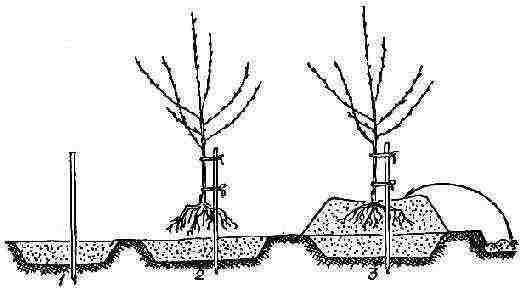
To prevent podoprevaniya root collar apricot is planted on a mound
If there is no suitable place for planting an apricot, then it will be necessary to eliminate the causes of podoprevanie. When the snow falls on the thawed soil, which has not yet had time to freeze, you need to immediately free the bole from it. This will create conditions for freezing the soil under the root collar. At the end of winter, when melting has not yet begun, the snow is carefully removed from the trunk circle and grooves are dug to drain the melt water. but The best way to prevent podoprevaniya is to graft apricot into the stem of plums, thorns and cherry plums at a height of 60–80 cm.
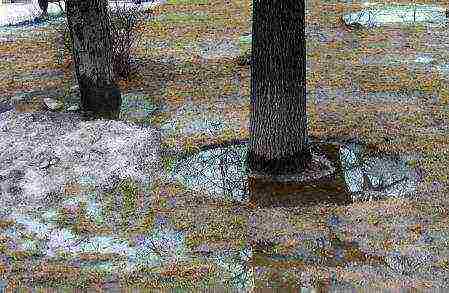
To prevent podoprevaniya root collar, it is necessary to clean the trunk circle from snow and drain melt water
Dessertny is planted, like all vigorous varieties, at a distance of 5-6 meters. If the soil has a dense structure, drainage is laid at the bottom of the planting pit to regulate the moisture level. Otherwise, when planting Dessertnoy, they comply with the standard requirements, as for other representatives of this culture.
Apricot Care Dessert
Apricot Dessert, a vigorous tree with a rather dense crown, so it is important not to start forming it immediately after planting. For trees with such characteristics, it is better to use a sparse-tiered crown formation, which is carried out in stages over 4–5 years. Every autumn, before the onset of frost, sanitary pruning is carried out: dry, damaged and diseased branches are removed.
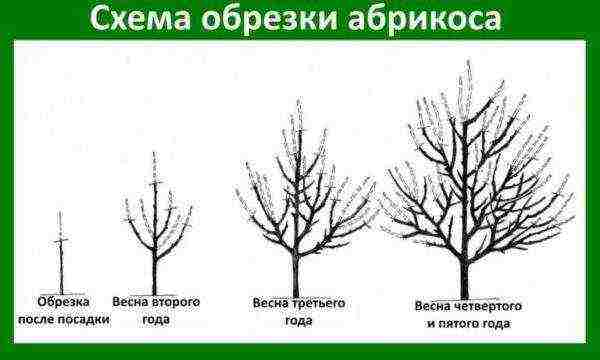
The formation of a sparse-tiered apricot crown is carried out from the moment of planting a seedling within 4-5 years
Since the flower buds of the Dessertny variety tree can freeze out during recurrent frosts, it is recommended to take measures to protect them. One of the recommendations is to cover the crown of the tree during flowering with agril, leaving room for insects to fly in, which pollinate the flowers. Theoretically, this is true, but in practice, perhaps, this is only possible when the tree is still young and has not reached a significant size. And the cost of the covering material, most likely, will not justify itself.
Another method of protection is to smoke the garden with fires made of long-smoldering materials (straw, dead leaves, dried grass). In practice, this method is highly dependent on the presence and direction of the wind. Smoke can be carried away by the wind in the other direction, or, with complete calm, it can stand in one place, not covering the entire territory. But if the fires are positioned correctly and the wind blows in the right direction, then the blooming garden can be protected from the temperature drop to -5 ° C.
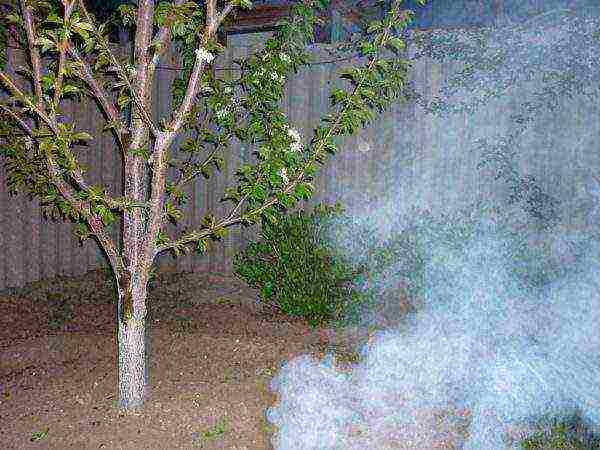
Smoke from campfires will protect flowering trees from frost
Apricot is considered a drought tolerant crop. Yes, without watering the tree will not die, but the yield will decrease significantly. During the season, it is advisable to water the apricot 3-4 times, this is especially necessary for it immediately after flowering and during intensive growth of fruits.
If during planting a sufficient amount of organic matter was introduced, then during the first three years no additional feeding is needed. Then, once every 3-4 years, organic matter (humus, compost) is introduced at the rate of 4-5 kg per 1 m2. With the beginning of fruiting, complex mineral fertilizers are applied annually. Fertilizers containing nitrogen can only be used in the first half of summer.
It is important to remember that nitrogen fertilizers contribute to the active growth of shoots and slow down their ripening - this negatively affects winter hardiness and resistance to podoprevanie.
Video: how to properly prune an apricot
Diseases and pests
The Dessert variety is distinguished by its resistance to diseases, but under unfavorable conditions (cold and rainy summers) it can be affected by fungal diseases.
Table: the most common apricot diseases and their symptoms
Photo gallery: common fungal diseases of apricot
To prevent fungal diseases, it is sufficient to timely carry out preventive spraying with a 3% solution of Bordeaux liquid, copper sulfate or other fungicides (Fundazol, Horus) according to the instructions.
To prevent damage to trees by pests, sanitary measures are taken in the fall. Fallen leaves are collected and destroyed. They dig up the soil, which contributes to the death of harmful larvae wintering in its upper layer. Whitewashing the trunk and skeletal branches with lime scares away insects and mice. To protect against rodents, the lower branches and trunk of young apricots are wrapped with durable materials or thorny spruce branches.
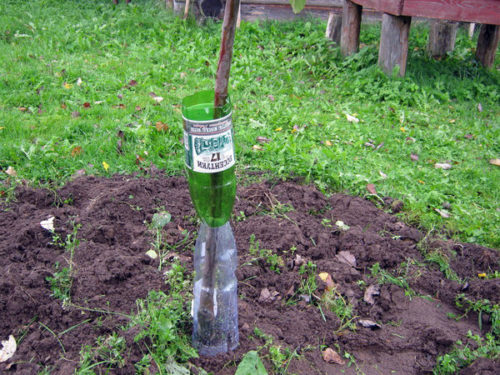
One way to protect a young seedling from rodents with plastic bottles
Variety reviews
The winter hardiness of Dessertny apricot makes it valuable for growing in a problematic region for this crop - central Russia. There are not many northern varieties that combine hardiness with great taste. When growing Dessert apricot, you can get a high yield if you take into account the climatic characteristics of the growing region and take timely preventive measures.
I have several professions of different profiles, including a musician and an accountant. Higher education. Rate the article:
(0 votes, average: 0 out of 5)
The Moscow region is not the best region for growing trees such as apricots. However, people love to compete with nature and create new varieties that, even in the Russian climate, are capable of producing tasty and sweet fruits. What varieties of apricots can be chosen for cultivation in the Moscow region, and other areas of Central Russia? As it turns out, there are a lot of them, there are plenty to choose from.
Iceberg
The Iceberg variety is fast-growing, early, frost-resistant. The fruits can be used for conservation, drying and fresh consumption.
The variety was bred by specialists of the Main Botanical Garden in 1986 by free pollination. Listed in the State Register as suitable for planting in the Central Region.
The tree is low - up to 3.5 meters, with branched shoots. The fruits are large, slightly compressed from the sides - which is a distinctive feature of the variety. Their weight is 20-23 grams. The skin is velvety, thin, rich yellow, with reddish-brown dots. The pulp meets the standards - it is sweet and aromatic. The stone is small, well separated.
The advantages of the variety include such qualities as large-fruited, frost resistance, early fruiting, disease resistance, good transportability, tasty fruits.
Among the disadvantages are susceptibility to fungal diseases in rainy weather, exactingness to soil and fertilizers. In the photo, an apricot iceberg:
Iceberg
Alyosha
Variety Alyosha - very early, the fruits ripen by the middle of summer. They are not too large, weighing 15-20 grams, bright yellow with a slight blush. The bone takes up a lot of space, but it has a delicious nucleolus. The pulp is tasty and firm, orange in color. The tree is not tall - about 3.5-4 meters, the crown is round, spreading.
The fruits are medium-sized, but the variety is considered high-yielding, since there are still quite a lot of them, from 50 to 80 kg of fruits are harvested from one adult tree.
The variety is frost-resistant, suitable for growing in the Russian central lane and the Moscow region. The fruits are eaten fresh, or they are made into preservation - compotes, jams.
Trees of this variety give many root shoots that must be cut to the ground, a large number of shoots negatively affects the quality and quantity of the crop.
Alyosha
Aquarius
Apricot of the Aquarius variety is not worse than the southern varieties, while it has high frost resistance and can be grown in the Moscow region.
The variety was obtained by free pollination of another variety - Lel, the work was carried out by employees of the Main Botanical Garden of Russia.
The tree is tall, up to 7 meters. Annual shoots are weakly branched, abundant flowering, white flowers. Fruits are round, weighing within 30 grams, yellow in color, with a slight blush. The pulp is orange, medium density, tasty. The stone is not large, it is easily separated. In the photo, the fruits of the apricot Aquarius:
Aquarius
Voronezh
Voronezh large variety has high cold resistance and resistance to typical diseases. The variety is self-pollinated, obtained as a result of pollination of the varieties Tovarishch and Krasnoshchekiy. The trees are of medium height - about 3-4 meters, the crown is oval.
Fruiting begins in the third year, fruits ripen early - already at the end of July. They are velvety, yellow-orange, weighing 35-40 grams. See the photo:
Voronezh
The pulp is aromatic, dense, amber, sweet and juicy. The stone is easily separated, it contains a delicious nucleolus.
Hardy
Variety Hardy - the name speaks for itself. The tree withstands low temperatures in winter and spring, and in summer the fruits ripen early, and turn red not from frost, but from the sun:
Hardy
Hardy is really the most stable among the varieties zoned for the Moscow region. Both trees and flower buds are resistant to frost.
The tree grows quickly, reaching a height of 4-5 meters, has a rounded crown. Fruiting begins 5-6 years after planting, and the tree immediately gives a high yield - up to 70 kg per tree. Fruits appear in mid-August. They are round, orange with a red blush, their weight is 30-45 grams. On the skin there is a characteristic light fluff, the pulp is tasty, sugary, aromatic, also orange in color. The stone is easily separated, the seeds in the seeds are sweet, they can be used raw, or added to apricot jam.
Dessert
The Dessertny variety is the result of the work of specialists from the Voronezh Agricultural Institute, who pollinated the apricot of the Lewise variety with the pollen of the Best Michurinskaya and Tovarish varieties. The Dessertny variety is distinguished by the early ripening of fruits, therefore it is recommended for planting on personal plots in the Central Black Earth Region.
The variety is winter-hardy, resistant to typical diseases and bark rot. It grows quickly, the crown of the trees is thick and wide, round in shape. The trees are tall, up to 5 meters or more in height. Flower buds have average winter hardiness.
Dessert is a self-pollinated variety; it is not necessary to plant apricots of other varieties next to it. Fruits appear in the 4th year after planting. They are light orange with a slight blush on their thin skin. The pulp is light yellow, sweet and sour. The weight of one fruit is about 30 grams.
The stone is small, making up no more than 10% of the weight of the apricot. In ripe fruits, it is easily separated from the pulp. The commercial quality of the products is not worse than that of the southern varieties. All this suggests that the Dessert variety is one of the best varieties for growing in the northern regions.
It is better to plant Dessertny saplings in the spring, before the juice starts to move, choosing for them light and protected from the winds places. Seedlings sold in containers with soil take root especially well.
In the photo Dessert apricot:
Dessert
Michurinsky
The best Michurinsky variety was bred back in 1926 from the seedlings of Siberian varieties sent to the famous breeder Michurin from the Far East in 1925.
The seedling of the Best Michurinsky gave its first fruits in 1931, although for the first time it bloomed a year earlier. Then the flowers were damaged by spring frosts, reaching minus 8 degrees.
The seedling also survived the severe frosts of 1928-1929, when old fruit trees were frozen all over Russia. The best Michurinsky survived this period without losses, even the tips of annual shoots did not freeze.
Excellent indicators for frost resistance made it possible to use the variety for breeding new varieties of apricots that can be grown in frosty winter conditions.
The variety gives a good harvest, it has so many fruit buds on the branches that it is difficult to find shoots with sprouting buds for summer budding. In a productive year, up to 80 kg of fruits are harvested from an adult tree.
The fruits of the Best Michurinsky are oval, flattened at the bottom and top. Fruit diameter is about 4-5 cm, weight - up to 20 grams. The color is golden yellow. The skin itself is fluffy, dense, difficult to separate from the pulp. The pulp is dense, rich yellow, sweet, with a slight bitterness that comes from the skin.
Fruit ripening begins early - in mid-July. In the photo the Best Michurinsky apricot:
Michurinsky
Honey
The Honey variety, according to gardeners, is self-fertile, reliable and high-yielding. The tree is average in height - about 4 meters, capable of withstanding frosts down to minus 35 degrees. Fruiting begins from the 4th year of planting. The fruits ripen in July-August. One tree gives up to 25-30 kg of fruits.
They are not large, yellow, with red dots-spots and light down. The pulp is fibrous, dense, yellow, tasty. The bone is separated quickly.
The variety is unpretentious to soils, it can grow even on salty soil. The fruits are suitable for conservation and fresh consumption.
Honey
Monastyrsky
The Monastyrsky variety is fruitful, frost-hardy and late, the fruits ripen by the end of August - beginning of September. Fruits are large, slightly elongated, weighing about 30-40 grams, some specimens are tightened to 50 grams. They are deep yellow in color, with a reddish tint. The pulp is mealy, tasty, the stone with the nucleolus is large, easily separated.
Monastic apricot is unpretentious in care, grows on any soil. In a spacious place, it can grow up to 5 meters, the crown is spreading, branchy, some gardeners consider this feature of the variety to be its disadvantage.
The variety is self-fertile, but yields fruits only from the fifth year after planting. Its advantages include long shelf life, portability, and disease resistance.
Monastyrsky
Tsarsky
Variety Tsarsky - what can you say about an apricot with this name? He has no special "royal" qualities. The tree grows slowly, and rarely exceeds 3-4 meters, the branching is average.
Fruits are medium in size - about 20 grams in weight, the yield is also average - about 40 kg per tree per year. However, fruiting is observed every year, starting in the third or fourth year after planting. Ripening occurs in early August.
In the photo Tsar's apricot:
Tsarsky
Apricots are oval in shape, with a thick skin, on which a characteristic downy is noticeable. The color is yellow with a carmine blush. They are juicy, soft and tasty, the seed is small and easily separated.
But the Tsarsky variety has one remarkable feature - high frost resistance, the ability to tolerate a decrease in temperature to -40 degrees. Good immunity helps him to resist typical diseases. The variety is self-fertile, only one tree can be planted in the garden.
